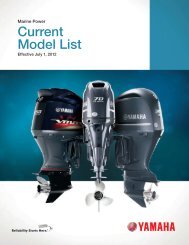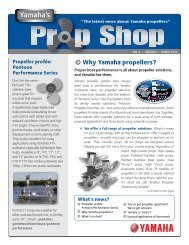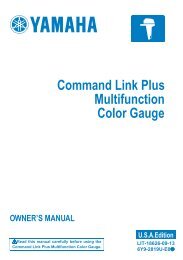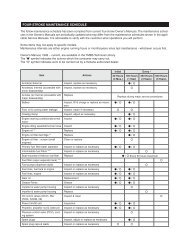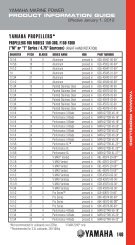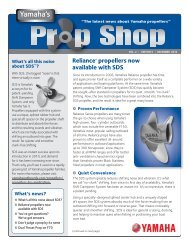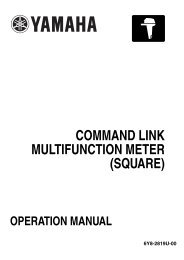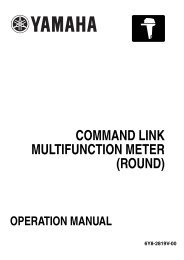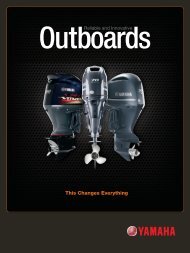Prop Shop VOL 1 EDITION 4 - Yamaha Outboards
Prop Shop VOL 1 EDITION 4 - Yamaha Outboards
Prop Shop VOL 1 EDITION 4 - Yamaha Outboards
Create successful ePaper yourself
Turn your PDF publications into a flip-book with our unique Google optimized e-Paper software.
<strong>Yamaha</strong>’s<br />
Keeping It Clean<br />
Over time, depending on how you care<br />
for your propeller and the environment<br />
in which you use it,<br />
what most folks call<br />
“rust and corrosion”<br />
can appear on the<br />
surface of a prop.<br />
So why is this, and<br />
what can be done<br />
to prevent it<br />
First, it’s important to remember the<br />
propellers are stainless not stain-proof.<br />
We test and re-test our props to help<br />
ensure maximum resistance to corrosion<br />
while still maintaining the necessary<br />
hardness in metallurgy. But because<br />
there is a measure of iron contained<br />
in any stainless steel propeller, surface<br />
discoloration can appear over time.<br />
This surface discoloration is somewhat<br />
normal in certain instances. It doesn’t<br />
affect performance, just appearance.<br />
The best prevention is to thoroughly rinse<br />
the props with fresh water (and perhaps<br />
mild liquid soap) after each use. For more<br />
stubborn stains, you might also try a soft<br />
rag and spray-on household bathroom<br />
cleaner, hydrogen peroxide, or a mild<br />
rubbing compound. It’s very important,<br />
however, that you<br />
rinse the prop<br />
immediately<br />
and<br />
thoroughly<br />
with<br />
fresh, clean water<br />
after using these.<br />
Remember, since surface discoloration is<br />
not a defect in materials or workmanship,<br />
and the environment in which a prop is<br />
used and how it’s maintained is beyond<br />
our control, this condition is not covered<br />
under either the <strong>Yamaha</strong> or PPI Limited<br />
Warranty.<br />
Unusual Application of the Month<br />
What about propping at high altitudes<br />
Air at higher elevations is less dense<br />
and therefore contains less oxygen,<br />
which causes most engines to produce<br />
less power, including outboards. To<br />
help counteract this effect, you’ll<br />
need to use a propeller with less pitch<br />
than you would at, say, sea level, in<br />
order to produce proper wide open<br />
throttle rpm. But how much less<br />
Using a properly-performing propeller at sea level as a baseline guide, a<br />
very general rule of thumb is: From sea level to about 2500’ above sea<br />
level, no change in pitch is necessary. After that, drop about 1” of pitch<br />
size for every 1000’ of additional elevation to help keep the WOT rpm<br />
in the correct range.<br />
Here’s a very general run-down*:<br />
Up to 2500’ – same as sea level<br />
2501’ to 3500’ – deduct 1” of pitch<br />
3501’ to 4500’ – deduct 2” of pitch<br />
4501’ to 5500’ – deduct 3” of pitch<br />
5501’ & up – deduct 4” of pitch<br />
Also, avoid four-blades and real aggressive props with high rake angles.<br />
These make the engine struggle to create rpm. Less blade area and<br />
lower rake helps the engine develop rpm faster.<br />
You can find ‘baseline’ propeller values for various set ups in our<br />
Performance Bulletins http://www.yamaha-motor.com/<br />
outboard/products/perfbull.aspx<br />
*Pitch reduction amounts are estimates only, and are intended as a guideline only. Your results may vary. Large displacement<br />
engines, particularly late model fuel-injected four stroke V6s, typically require less pitch reduction for proper performance<br />
than smaller displacement engines. On-water testing is always best to determine proper performance.<br />
If you’d like more information i about which <strong>Yamaha</strong> propeller is right<br />
for your needs, contact your local authorized <strong>Yamaha</strong> Marine Dealer at<br />
http://www.yamaha-motor.com/outboard/dealers/dealerhome/home.aspx<br />
Also, feel free to check us out on Facebook at<br />
http://www.facebook.com/yamahaoutboards<br />
We’ll be happy to help you get pointed in the right direction.<br />
Turbo ® propellers are manufactured by Precision <strong>Prop</strong>eller Industries, Inc., a wholly-owned subsidiary of <strong>Yamaha</strong>.<br />
This document contains many of <strong>Yamaha</strong>’s valuable trademarks. It may also contain trademarks belonging to other<br />
companies. Any references to other companies or their products are for identification purposes only, and are not<br />
intended to be an endorsement.<br />
Due to <strong>Yamaha</strong>’s ongoing commitment to product improvement,<br />
we reserve the right to change without notice, equipment,<br />
materials, or specifications.<br />
© 2011 <strong>Yamaha</strong> Motor Corporation, U.S.A. All rights reserved.



